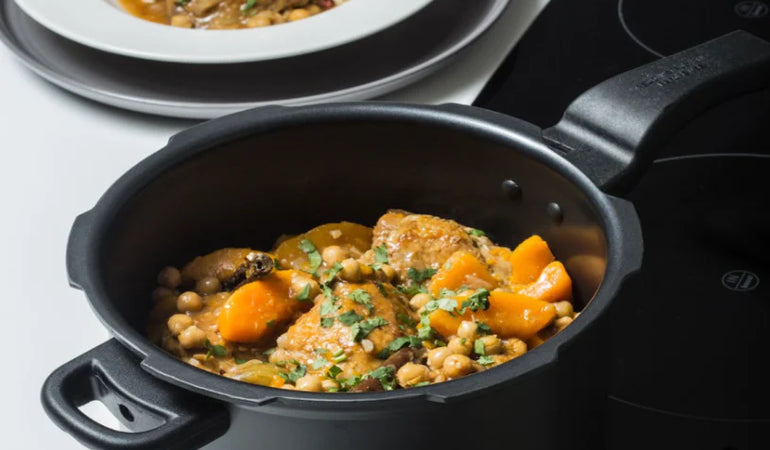Mastering the Art of Cooking Glutinous Rice in a Pressure Cooker
Written By James Morgan
How to cook glutinous rice in a pressure cooker is a skill that every home chef should master, especially if you love indulging in delicious Asian cuisine. This traditional Asian staple, often referred to as sticky rice, is known for its distinctive chewy texture and is used in a variety of delectable dishes from sweet desserts to savory mains.

The Allure of Glutinous Rice
Glutinous rice, also known as sticky rice, is a type of rice grown mainly in Southeast and East Asia, which has opaque grains and becomes especially sticky when cooked. Despite its name, glutinous rice contains no gluten; the name refers to its glue-like stickiness. This particular type of rice is rich in amylopectin, a type of starch that gives the rice its signature texture. Its chewy consistency and ability to hold spices and flavors make it an essential ingredient in many Asian households.

Why Use a Pressure Cooker?
Cooking glutinous rice can be quite tricky and time-consuming when done using traditional methods. Usually, it involves soaking the rice for several hours, followed by steaming. However, the invention of the pressure cooker has revolutionized the process. Using a pressure cooker significantly cuts down on cooking time while ensuring the rice is evenly cooked, preserving its delightful texture and taste. For a high-quality pressure cooker, consider this option.

Essential Tools You'll Need
- Pressure Cooker: A must-have for this recipe, ensuring even cooking and reduced time.
- Knife: To chop any additional ingredients, opt for a reliable knife.
- Cutting Board: An essential for preparing ingredients, find a sturdy one here.
:max_bytes(150000):strip_icc()/Instant-Pot-Duo-Evo-Plus-2000-78b1640b28324a59b7dcba0603483e3b.jpg)
Ingredients and Preparation
- 2 cups of glutinous rice
- 2 cups of water
- Pinch of salt (optional)
Step-by-Step Guide on How to Cook Glutinous Rice in a Pressure Cooker
Step 1: Rinse the Rice
Before anything else, it's crucial to rinse the glutinous rice thoroughly. Place the rice in a bowl and rinse under cold water, gently stirring the grains with your fingers. Repeat this process several times until the water runs clear. Rinsing helps to remove excess starch, which could otherwise make the rice too sticky and gummy when cooked.
Step 2: Soak the Rice
Once rinsed, soak the rice in cold water for about 30 minutes. This step helps the grains to start absorbing water, making them cook more evenly and quickly in the pressure cooker. While traditional methods typically call for several hours of soaking, the pressure cooker allows us to cheat a bit and cut this time down significantly.
Step 3: Drain the Rice
After soaking, be sure to drain the rice thoroughly. Any excess water at this point can throw off the water-to-rice ratio that is vital for achieving the perfect texture. A colander can be quite useful for this step, ensuring all the water is drained out efficiently.
Step 4: Measure and Add Water
Drained and ready, transfer the rice to the pressure cooker. Add 2 cups of water to the 2 cups of glutinous rice. For those seeking a bit of extra flavor, a pinch of salt can be added at this stage, but it's entirely optional. The water-to-rice ratio is crucial for achieving the ideal texture, so ensure it's measured accurately.
Step 5: Set the Pressure Cooker
Secure the lid of the pressure cooker and set it to high pressure. Cooking time is typically around 12 minutes, but it may vary slightly depending on your specific pressure cooker model. The beauty of using a pressure cooker lies in its efficiency; within these 12 minutes, the rice cooks thoroughly, resulting in a soft, chewy texture.
Step 6: Natural Release
Once the cooking time is up, allow the pressure to release naturally. This means letting the cooker sit until the pressure drops on its own, which usually takes about 10-15 minutes. This step ensures that the rice finishes cooking gently without becoming mushy.
Step 7: Fluff and Serve
After the pressure has fully released, open the lid carefully. Use a rice paddle or fork to fluff the glutinous rice gently. This helps to separate the grains and releases any trapped steam. Your perfectly cooked glutinous rice is now ready to be enjoyed!
Serving Suggestions and Variations
Glutinous rice is incredibly versatile and can complement a myriad of dishes. It can be paired with savory meats, aromatic curries, or even sweet coconut milk for a delightful dessert. Here are some popular variations:
- Mango Sticky Rice: A classic Thai dessert with sweet mango slices and coconut milk.
- Sticky Rice with Chicken: A hearty main dish with tender pieces of chicken and flavorful soy sauce.
- Stuffed Glutinous Rice: Fill rice balls with sweet red bean paste for a delicious treat.
Maintaining Your Cookware
After preparing such an exquisite dish, it's crucial to take care of your cookware to ensure longevity and performance. Clean your pressure cooker thoroughly after use. For maintaining your cutting board and knife, consider using specialized cleaning products:
As an Amazon Associate, I earn from qualifying purchases.
Conclusion
Learning how to cook glutinous rice in a pressure cooker opens up a world of culinary possibilities. Not only does it save time, but it also ensures a consistent, delectable texture that's hard to achieve with traditional methods. Whether you're a seasoned cook or a novice in the kitchen, this approach simplifies the process and elevates your rice-cooking game. Enjoy experimenting with different flavors and dishes, and delight in the rich, sticky goodness of glutinous rice.
For more in-depth information about the science behind pressure cooking, check out this resource.
Related Articles
If you enjoyed this recipe, you might also like: Cook Ham, Grilled Chicken, and Barbecue Tips.



